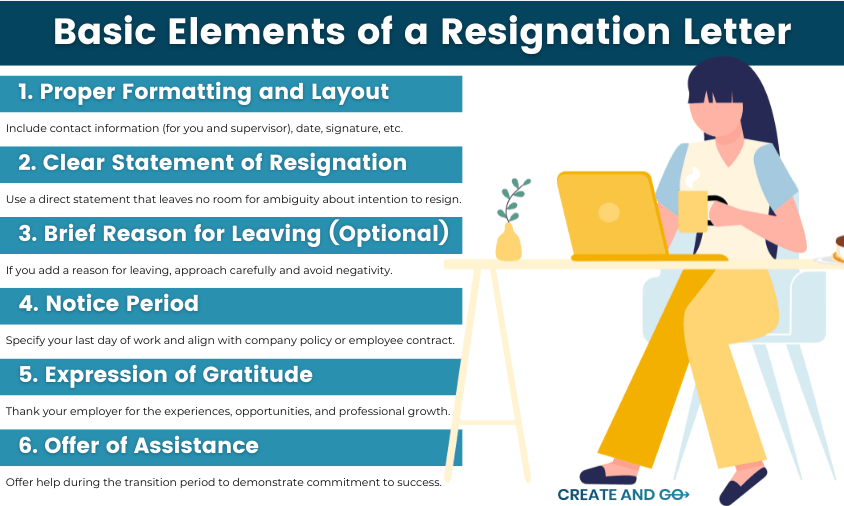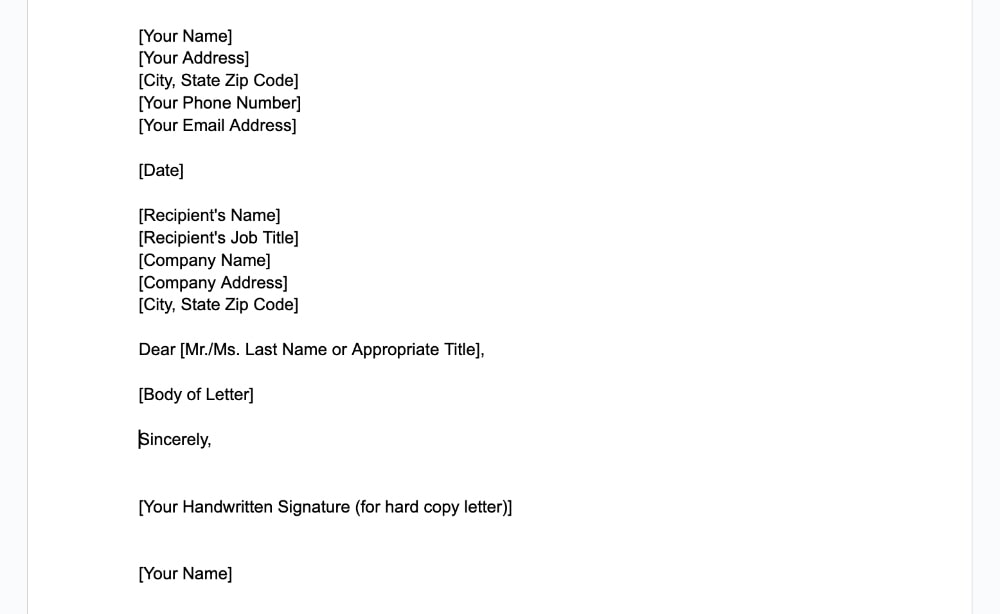
We partner with bada$$ companies that offer products that help our readers achieve their goals! If you purchase through our partner links, we get paid for the referral at no additional cost to you! Read our disclosure for more info.
Quitting a job can be an emotional rollercoaster that can include both ups and downs, depending on your situation. No matter the reason for moving on—whether it’s a better job, a career change, or other personal circumstances—submitting a resignation letter is an essential step in the process.
It’s a professional courtesy that ensures a smooth transition and helps maintain a positive relationship with your current employer. It’s also something that it’s in demand now more than ever.
In 2022, approximately 50.5 million individuals chose to part ways with their employers, surpassing the previous record set in 2021.
But let’s be real, drafting that resignation letter can be a daunting task. You want to strike the right tone, convey your gratitude, and avoid burning any bridges.
I know that when I left my last job, I didn’t even submit a formal resignation letter. I just told my bosses, but this isn’t the most professional way to do it. You need to formally notify your place of employment when you’re looking to transition.
In the following guide, we’ll dive deep into the art of writing an effective and professional resignation letter. We’ll explore why it’s so crucial, the key elements that make a resignation letter shine, and provide step-by-step instructions to help you craft the perfect one.
Not only that, but we’ve also put together a collection of great resignation letter examples that cover various scenarios, from simple resignations to career changes and retirements.
These real-life examples will not only inspire you but also provide valuable insights into what works (and what doesn’t) when it comes to resignation letters.
Get ready to bid farewell to your current job with grace and professionalism.
While the act of resigning may seem straightforward, writing a formal resignation letter is a key step that shouldn’t be overlooked.

First and foremost, a resignation letter provides official documentation of your intention to leave your current role. It serves as a tangible record of your departure, which can be invaluable for future reference or in case of any misunderstandings down the line.
Secondly, a resignation letter presents an opportunity to express gratitude towards your employer and colleagues. It allows you to reflect on the positive experiences and memories you’ve gained during your tenure, fostering a sense of closure and maintaining positive relationships that could benefit you in the future.
Thirdly, a professional and respectful resignation letter can help preserve your reputation and serve as a valuable reference for future endeavors. By handling your departure with grace and professionalism, you increase the likelihood of receiving glowing recommendations from your former employer.
Table of ContentsLearning how to write a resignation letter may seem daunting, but it’s a lot more manageable when you break it down into the essential components and start from there.
At its core, a resignation letter should be a concise and straightforward document that conveys your intention to leave your current role.
However, there are a few key elements that can elevate your letter from a mere formality to a polished and professional piece of communication:

Before hitting “send,” take the time to carefully proofread and edit your resignation letter.
Check for any spelling or grammatical errors, and ensure that the tone remains professional and courteous throughout.
While not a substitute for human review, proofreading tools like spell checkers and grammar checkers can be valuable resources for catching common errors. We like Grammarly.
Now that we’ve covered the essential elements of a resignation letter, it’s time to dive into the nitty-gritty of actually crafting one. Don’t worry; we’ve got your back with this easy-to-follow, step-by-step guide!
Let’s start with the basics. A well-formatted resignation letter not only looks professional but also ensures that your message is conveyed clearly.
Here’s a step-by-step breakdown of the proper formatting and layout:
Remember, attention to detail can make a lasting impression and help maintain positive relationships with your employer.
When it comes to resigning from a position, clarity is paramount.
You want to leave no room for ambiguity or misinterpretation regarding your intention to depart from the company.
Begin the body of your letter with a straightforward statement that explicitly communicates your resignation. A simple yet effective approach is to use a variation of the following:
“Please accept this letter as formal notification of my resignation from [Your Job Title] at [Company Name].”
After clearly stating your resignation, you may choose to include a brief sentence or two providing context for your decision.
If you choose to include a reason for your resignation, it’s generally advisable to keep it concise and focused on the future, rather than providing reasons that reflect poorly on your employer, colleagues, or the company itself.
If you’re resigning due to a new opportunity, you could say something like:
“I have accepted a position at [New Company Name] that aligns more closely with my long-term career goals.”
If personal circumstances are the driving factor, you could state:
“Due to recent family obligations, I have made the difficult decision to resign from my position.”
If you prefer to keep the details of your departure private or simply wish to avoid any potential misunderstandings, you can respectfully omit a specific reason from your resignation letter.
Next, you’ll want to provide your two weeks’ notice or your other date for your final day of work.
Providing adequate notice is not only a professional courtesy but also a legal requirement in many cases.
Most companies have a standard notice period outlined in their policies or employment contracts, typically ranging from two weeks to a month or more, depending on your position and industry.
Make sure you check your employment contract and adhere to it when drafting your resignation letter.
In the body of your letter, clearly state your planned last day of work. For example:
“Please accept this letter as formal notification of my resignation from [Your Job Title] at [Company Name]. My last day of employment will be [Date].”
By providing a specific date, you eliminate any confusion or ambiguity regarding your departure timeline. This information is crucial for your employer to make necessary arrangements, such as reassigning your responsibilities or initiating the hiring process for your replacement.
If your notice period extends beyond the standard two weeks, consider offering to assist with the transition process during this time.
A heartfelt thank-you can go a long way in maintaining positive relationships.

No matter the circumstances surrounding your departure, it’s essential to express sincere gratitude towards your employer, colleagues, and any mentors who have played a role in your professional journey.
For this part, make sure to be specific and genuine. Take a moment to reflect on the positive experiences, opportunities for career growth, and valuable lessons you’ve learned.
If you want to highlight the team that you worked with, you could say:
“I would like to express my sincere gratitude to [Company Name] for the invaluable experiences and opportunities for professional growth that I have been afforded during my time here. Working alongside such a talented and dedicated team has been truly rewarding, and I will carry the lessons learned with me as I embark on this new chapter.”
If you had a particular mentor at your company worth mentioning, you could say:
“I am deeply grateful for the mentorship and guidance provided by [Mentor’s Name] throughout my tenure at [Company Name]. Their unwavering support and commitment to my development have been instrumental in shaping my career path, and I will forever cherish the knowledge and wisdom they have imparted.”
Or if you just want to express general gratitude, you could say:
“Thank you for the trust and confidence you have placed in me over the years. It has been an honor to contribute to the success of [Company Name], and I am grateful for the opportunities to collaborate with such a remarkable group of professionals.”
Now it’s time to demonstrate your commitment to the company’s success by offering to assist with the transition process.
This could involve training a replacement, ensuring project handover, or providing any other support necessary to ensure a smooth changeover.
Here are some examples of how you might phrase your offer of assistance:
This gesture not only helps maintain positive relationships but also increases the likelihood of receiving favorable references or recommendations from your former employer in the future.
If you’ve had a positive experience with your employer and anticipate needing professional references in the future, don’t hesitate to request letters of recommendation.
A recommendation can serve as a testament to your skills, work ethic, and accomplishments and also increase your chances of standing out in a competitive job market.
When making this request, it’s important to approach it with professionalism and respect for your colleagues’ time and effort. Consider the following tips:
To help illustrate the key elements and best practices, I’ve provided a diverse range of resignation letter templates below that are tailored to various scenarios.
All of the following resignation letter templates will use the same formatting for the contact information for you and the company:

The Intro
[City, State Zip Code]
[Your Phone Number]
[Your Email Address]
[Recipient’s Job Title]
[City, State Zip Code]
Dear [Mr./Ms. Last Name or Appropriate Title],
And outro:
[Your Handwritten Signature (for hard copy letter)]
This straightforward template includes all the fundamental elements of a resignation letter, making it suitable for most standard resignation scenarios.
It covers the essential components such as the date, recipient’s details, a clear statement of resignation, final notice, and an expression of gratitude.
“Dear [Mr./Ms. Last Name or Appropriate Title],
Please accept this letter as formal notification of my resignation from the position of [Your Job Title] at [Company Name]. My last day of employment will be [Your Intended Last Day of Work], in accordance with the [Notice Period] outlined in my employment agreement.
I would like to express my sincere gratitude for the opportunities and experiences I have gained during my time at [Company Name]. Working alongside such a talented and dedicated team has been truly rewarding, and I will carry the lessons learned with me as I embark on this new chapter.
During the remaining [Notice Period], I will make every effort to ensure a smooth transition of my responsibilities. I am happy to assist in training my replacement and providing detailed documentation to facilitate a seamless handover process.
Thank you again for the support and guidance you have provided me throughout my tenure at [Company Name]. I wish you and the entire team continued success in the future.”
If you’re resigning due to a specific reason, such as accepting a new job opportunity or pursuing further education, this template provides a professional way to communicate your rationale while maintaining a positive tone.
It includes a dedicated section for explaining your reason for leaving in a tactful and respectful manner.
Here’s a resignation letter template that includes a section for providing a reason for leaving:
Transitioning to a new career path can be an exciting yet daunting prospect.
This resignation letter sample is tailored specifically for those embarking on a career change, allowing you to convey your decision with clarity and enthusiasm while expressing gratitude for the experiences and opportunities gained in your current role.
Here’s a resignation letter template tailored for those embarking on a career change:
“Dear [Mr./Ms. Last Name or Appropriate Title],
Please accept this letter as formal notification of my resignation from the position of [Your Job Title] at [Company Name]. My final date of employment will be [Your Intended Last Day of Work], in accordance with the [Notice Period] outlined in my employment agreement.
After [Number] years of dedicated service, I have made the difficult decision to transition into a new career path that better aligns with my long-term goals and aspirations. While this decision was not an easy one, I believe it is the right time for me to explore new opportunities and pursue my passion for [New Career Field/Industry].
I would like to express my sincere gratitude for the invaluable experiences and opportunities for growth that I have been afforded during my tenure at [Company Name]. Working alongside such a talented and dedicated team has been truly rewarding, and I will carry the lessons learned with me as I embark on this new chapter.
During the remaining [Notice Period], I will make every effort to ensure a smooth transition of my responsibilities. I am happy to assist in training my replacement and providing detailed documentation to facilitate a seamless handover process.
Thank you again for the support and guidance you have provided me throughout my time at [Company Name]. I wish you and the entire team continued success in the future.”
After years of dedicated service, retiring from your position is a significant milestone.
This template helps you craft a resignation letter that celebrates your accomplishments, expresses appreciation for the company and colleagues, and sets the stage for a graceful transition into retirement.
Here’s a resignation letter template tailored for those retiring from their position:
“Dear [Mr./Ms. Last Name or Appropriate Title],
After [Number] years of dedicated service to [Company Name], I am writing to formally notify you of my decision to retire from my position as [Your Job Title], effective [Your Intended Last Day of Work].
As I reflect on my tenure with the company, I am filled with a profound sense of gratitude for the opportunities, challenges, and successes that have shaped my professional journey. Working alongside such a talented and dedicated team has been an honor and a privilege, and I will cherish the memories and relationships forged throughout these years.
While the decision to retire was not an easy one, I believe it is the right time for me to embark on this new chapter and pursue personal interests and passions that have been put on hold during my career. I am excited to explore the possibilities that lie ahead, but I will always look back fondly on my time at [Company Name].
During the remaining [Notice Period], I will make every effort to ensure a smooth transition of my responsibilities. I am happy to assist in training my replacement and providing detailed documentation to facilitate a seamless handover process.
Thank you for the support, guidance, and trust you have placed in me throughout my tenure. I wish you and the entire team at [Company Name] continued success in the years to come.”
In some cases, you may need to request an extension of the standard notice period due to ongoing projects or personal circumstances.
This template provides guidance on how to respectfully request an extended notice period while offering to assist with the transition process and ensure a smooth handover of responsibilities.
Here’s a resignation letter template that includes a section for requesting an extension of the standard notice period:
“Dear [Mr./Ms. Last Name or Appropriate Title],
Please accept this letter as formal notification of my resignation from the position of [Your Job Title] at [Company Name].
I understand that the standard notice period outlined in my employment agreement is [Standard Notice Period]. However, due to [Reason for Extension Request, e.g., ongoing critical projects, personal circumstances], I respectfully request an extension of my notice period until [Proposed Last Day of Work].
This additional time will allow me to ensure a smooth and comprehensive transition of my responsibilities. During this extended notice period, I will make every effort to complete any outstanding tasks, train my replacement, and provide detailed documentation to facilitate a seamless handover process.
I remain committed to the successful completion of any ongoing projects or tasks under my purview. Please feel free to call upon me for consultation or support during this transition period to ensure continuity and minimize disruptions.
I would like to express my sincere gratitude for the opportunities and experiences I have gained during my time at [Company Name]. Working alongside such a talented and dedicated team has been truly rewarding, and I will carry the lessons learned with me as I embark on this new chapter.
Thank you for your understanding and consideration of my request for an extended notice period. I wish you and the entire team continued success in the future.”
To write a good resignation letter:
To write a short resignation letter:
To gracefully submit a letter of resignation, give the proper advance notice about your final day of work as outlined in your contract. Express your thanks for the opportunities and experiences you’ve had at the company. Offer assistance during the transition period to help train a replacement or complete outstanding work.
Avoid any negativity or criticism about the company or colleagues. Maintain a positive, professional tone throughout. Thank your employer and wish them continued success. If applicable, request letters of recommendation.
How do you politely resign from a job?To politely resign from a job, first inform your manager, then submit a formal resignation letter. In the letter, state your resignation clearly and specify your last day of work. Give adequate notice as per your contract or company policy. Express gratitude for the opportunities and experiences you’ve had. Offer to assist with the transition and knowledge transfer to a replacement.
Avoid negativity or burning bridges with the company. Maintain a respectful, professional tone throughout the letter. Thank your employer and colleagues for their support during your tenure.
Resigning from a job is a significant career transition that requires careful consideration and professionalism. By learning how to write a resignation letter, you not only demonstrate respect for your employer but also increase the likelihood of maintaining positive relationships that could benefit you in the future.
Remember, a professional resignation letter is a reflection of your character and work ethic. It’s an opportunity to leave a lasting impression and solidify your reputation as a valuable asset in the professional world.
Whether you’re pursuing a new opportunity, embarking on a career change, or retiring after years of dedicated service, resignation letters can pave the way for a smooth transition and open doors for future endeavors.
By following the guidelines and best practices outlined in this article and in the resignation letter templates, you’ll be equipped to navigate this often tough process with confidence, grace, and a touch of personal flair.
Lauren has been a professional blogger since 2016. With a degree in accounting, she has taken her life experience and business knowledge and used it to grow two blogs, Avocadu and Create and Go, to 6 and 7 figures. She spends a lot of her free time traveling with her husband. Read more about the team.